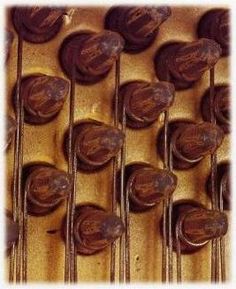 It can be one of the most expensive things that you’ll ever purchase next to your home or vehicle, yet most people know very little about how to care for a piano.
It can be one of the most expensive things that you’ll ever purchase next to your home or vehicle, yet most people know very little about how to care for a piano.
In this article, we will focus on the condition that has the greatest impact on the piano’s tuning stability and life expectancy – Humidity.
All acoustic pianos are primarily made of wood and metal, with other materials such as felt, cloth, and plastics or composites – we’ll explore the effects on wood and metal.
Let’s start off with the soundboard. This large sheet of spruce wood covers almost all of the length (height in upright pianos) and width of your piano. It acts like a speaker and amplifies the vibration of the strings. It takes in moisture from the air and swells when it’s humid, and gives up moisture and shrinks during dryer conditions. As the soundboard swells or shrinks, the piano strings tighten or loosen changing their individual pitch across the entire piano.
The action, or system of moving parts that includes the keys all the way up to the hammers, are typically made of wood. These too can be impacted by changes in humidity causing keys to stick, as well other related issues. Excessive dryness can also have an impact on other wooden parts like the tuning pin block and the bridge.
Now let’s consider the metal parts. The strings in a piano are made of steel, with the bass strings consisting of a steel core that are wound with copper. When moisture levels get high, rust or corrosion can form on the strings, which will dull their tonal quality and increase their likelihood to break, especially during tuning.
To minimize the impact of humidity changes, we need to control the piano’s exposure to humidity. This can be a challenge with humidity levels changing outside, and when we heat or cool the air we bring into our houses. Air conditioning during the summertime helps by drawing moisture out of the air, while furnaces heat the air and can remove too much moisture. Between the seasonal changes, we can experience a swing of home humidity from 15% RH (relative humidity) in the winter, to 75% RH in the summer. This can cause a major shift in the sound and performance of your piano, and have long-term effects.
The first step in controlling this is to understand how much it changes. You can pick up a tabletop hygrometer (humidity meter) for $25-$40 at most hardware stores. Once you understand how much the humidity changes, you can look at controlling it. If your home gets very dry during the colder months, you may need to replace the lost humidity with either a fixed humidifier on your furnace, or a portable humidifier in the piano room. Portables can work well, but just be sure that you don’t provide too much moisture and promote rust forming on the strings. Once the weather gets warmer, you’ll find you can turn off the humidifier. It’s at this stage we see a gradual increase in humidity and you may need to draw the humidity out of the air with a dehumidifier if you’re not ready for the air conditioning to go on.
To take it to the next level, there are more costly systems ($500-$600) that can be installed directly inside your piano that will maintain a controlled range of humidity. They require some regular maintenance, but provide a higher degree of control.
Keeping your piano at a controlled and stable humidity level (around 35 to 45% RH) will help maintain it’s correct pitch, hold a tuning longer, and prolong the life of your piano. Understanding how to care for your piano is the key to great music.
Lee Johnson